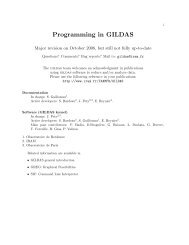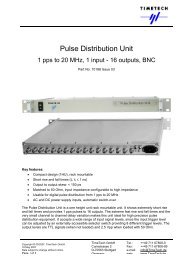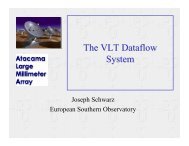class Continuum and Line Analysis Single-dish Software - IRAM
class Continuum and Line Analysis Single-dish Software - IRAM
class Continuum and Line Analysis Single-dish Software - IRAM
Create successful ePaper yourself
Turn your PDF publications into a flip-book with our unique Google optimized e-Paper software.
Chapter 1<br />
Introduction<br />
<strong>class</strong> is a software package for reducing spectroscopic data obtained on a single-<strong>dish</strong> telescope.<br />
It also has basic functionalities to reduce continuum drifts like pointing or focus.<br />
The originality of <strong>class</strong> with respect to similar systems already in use is in the way an<br />
observation may be identified. In addition to the traditional scan number which can be used to<br />
uniquely refer to an observation, the system also enables one to use Selection Criteria as in a<br />
data base management system. This faculty, added to a powerful comm<strong>and</strong> monitor, sic, allows<br />
easy manipulation of large volumes of data; the list of observation numbers to be added to get<br />
the mean spectrum at one position need no longer be typed in, but may be found by <strong>class</strong> itself.<br />
On a st<strong>and</strong>ard installation, <strong>class</strong> is entered by just typing <strong>class</strong>. <strong>class</strong> is divided in different<br />
parts, called “Languages”, which have somewhat independent functions:<br />
• Language LAS contains all the general utility functions to h<strong>and</strong>le the data structure, plot<br />
the spectra or drifts <strong>and</strong> calibrate them.<br />
• Language ANALYSE contains functions to analyse calibrated spectra in more detail.<br />
• Language FIT gathers the spectra fitting functionalities.<br />
Those languages are described in this manual. In addition, <strong>class</strong> imports many functionalities<br />
defined <strong>and</strong> documented in other gildas packages:<br />
• The comm<strong>and</strong> line interpretor is imported through the SIC (basic), GUI (for widgets) <strong>and</strong><br />
VECTOR (miscellaneous) languages.<br />
• The plotting possibilities through the GTVL (basic graphic actions), GREG1 (curve plotting),<br />
GREG2 (image plotting) <strong>and</strong> GREG3 (data cube plotting) languages.<br />
• And the ephemerids <strong>and</strong> atmospheric contributions through the ASTRO language.<br />
In addition to this manual, the reader should thus consult the sic manual, <strong>and</strong> for further<br />
processing, the greg manual.<br />
This version of the <strong>class</strong> documentation reflects the full rewritting of <strong>class</strong> in FORTRAN90.<br />
In this process, many things have been changed, hopefully improved. If you are an experienced<br />
<strong>class</strong> user, you may first want to consult the <strong>IRAM</strong> memo which describes only the changes in<br />
this version of <strong>class</strong>.<br />
1






